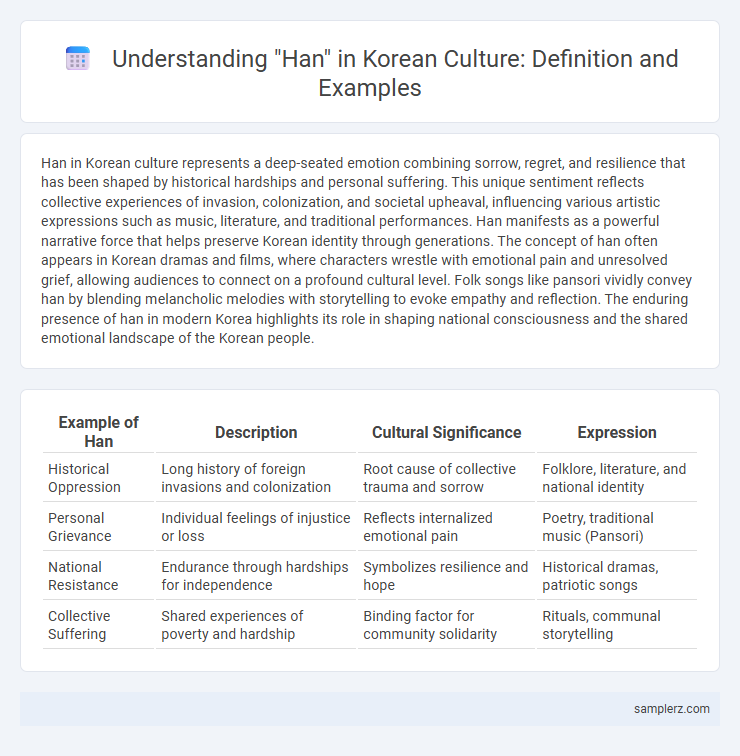Han in Korean culture represents a deep-seated emotion combining sorrow, regret, and resilience that has been shaped by historical hardships and personal suffering. This unique sentiment reflects collective experiences of invasion, colonization, and societal upheaval, influencing various artistic expressions such as music, literature, and traditional performances. Han manifests as a powerful narrative force that helps preserve Korean identity through generations. The concept of han often appears in Korean dramas and films, where characters wrestle with emotional pain and unresolved grief, allowing audiences to connect on a profound cultural level. Folk songs like pansori vividly convey han by blending melancholic melodies with storytelling to evoke empathy and reflection. The enduring presence of han in modern Korea highlights its role in shaping national consciousness and the shared emotional landscape of the Korean people.
Table of Comparison
| Example of Han | Description | Cultural Significance | Expression |
|---|---|---|---|
| Historical Oppression | Long history of foreign invasions and colonization | Root cause of collective trauma and sorrow | Folklore, literature, and national identity |
| Personal Grievance | Individual feelings of injustice or loss | Reflects internalized emotional pain | Poetry, traditional music (Pansori) |
| National Resistance | Endurance through hardships for independence | Symbolizes resilience and hope | Historical dramas, patriotic songs |
| Collective Suffering | Shared experiences of poverty and hardship | Binding factor for community solidarity | Rituals, communal storytelling |
Understanding Han: The Essence of Korean Cultural Identity
Han represents a complex emotional concept deeply rooted in Korean culture, embodying collective feelings of sorrow, resentment, and hope arising from historical hardships. It manifests in various cultural expressions such as traditional music (pansori), literature, and art, reflecting the Korean people's resilience and enduring spirit. Understanding han is essential to grasping the nuanced identity and emotional depth that shape Korea's cultural heritage.
Historical Roots of Han in Korea
Han in Korean culture originates from centuries of historical experiences marked by invasions, colonization, and social oppression. Rooted in the collective memory of the Korean people, han embodies a deep emotional response to suffering and injustice while simultaneously expressing resilience and hope. This cultural concept is reflected in traditional literature, music, and art, illustrating the enduring influence of han throughout Korea's history.
Han in Traditional Korean Literature
Han in traditional Korean literature embodies a deep collective feeling of sorrow, resentment, and unresolved grief rooted in Korea's history of invasions and social injustices. Classic works such as "The Tale of Chunhyang" and "Simcheongjeon" vividly portray characters enduring Han through sacrifice and endurance, highlighting the emotional depth and cultural resilience embedded in Korean narratives. This unique emotional concept not only shapes character development but also reflects broader themes of suffering and hope in Korea's literary heritage.
Manifestations of Han in Korean Art and Music
Han in Korean culture manifests deeply in traditional art forms such as pansori, a narrative musical performance characterized by expressive vocal inflections conveying sorrow and resilience. Visual arts like minhwa folk paintings often depict themes of endurance and collective suffering, symbolizing han through imagery of nature and everyday hardship. Modern Korean music, including ballads and indie genres, continues to channel han by expressing emotional pain and longing, reflecting the collective historical trauma embedded in Korean identity.
Han in Korean Cinema and Dramas
Han, a profound concept of collective grief and resilience, deeply permeates Korean cinema and dramas, shaping narrative themes and character development. Films like "Ode to My Father" and dramas such as "Moon Lovers: Scarlet Heart Ryeo" vividly portray Han through stories of sacrifice, loss, and enduring hope, resonating with audiences worldwide. This cultural emotion enhances the emotional depth, fostering a unique storytelling style that highlights Korea's historical struggles and emotional endurance.
Han in Family and Interpersonal Relationships
Han in Korean culture embodies deep, collective emotions rooted in historical suffering and unexpressed grief, significantly influencing family dynamics and interpersonal relationships. This emotional residue fosters a sense of resilience and empathy among family members, often leading to strong, enduring bonds marked by mutual support and understanding. Han shapes communication patterns by encouraging indirect expression of feelings, preserving harmony while conveying complex emotional undercurrents within close relationships.
Han and Major Historical Events in Korea
Han, a deeply ingrained concept in Korean culture, embodies collective grief and unresolved resentment shaped by historical events such as the Japanese colonial occupation (1910-1945) and the Korean War (1950-1953). This emotional and psychological state reflects the suffering endured during foreign invasions, division of the Korean Peninsula, and subsequent political turmoil. Han continues to influence Korean literature, music, and art, serving as a poignant reminder of national resilience and identity.
Han in Rituals and Traditional Practices
Han in Korean culture represents a deep-rooted emotional concept of collective grief and resilience expressed through rituals and traditional practices such as ancestral memorial ceremonies (jesa) and folk performances like pansori. These practices serve as a medium for channeling and preserving the communal sense of Han, often manifested in rhythmic chants, emotional storytelling, and symbolic offerings that acknowledge historical suffering while fostering healing. The embodiment of Han in these cultural rituals reinforces social cohesion and the continuity of Korean identity across generations.
Han’s Influence on Contemporary Korean Society
Han deeply influences contemporary Korean society by shaping collective identity through themes of sorrow, perseverance, and unresolved grievances rooted in historical trauma. Modern Korean literature, cinema, and music frequently explore Han to express complex emotional narratives, fostering social cohesion and cultural continuity. This enduring emotional framework also informs social behaviors and public discourse, reinforcing a shared understanding of resilience amid adversity.
Healing and Overcoming Han in Modern Korea
Han in Korean culture represents a deep-seated emotional pain stemming from historical trauma and oppression. Modern Korean society incorporates therapeutic practices like art therapy, music, and storytelling to facilitate healing and overcoming han. These cultural expressions enable individuals to process collective suffering and foster resilience in contemporary Korea.

example of han in Korean culture Infographic
 samplerz.com
samplerz.com